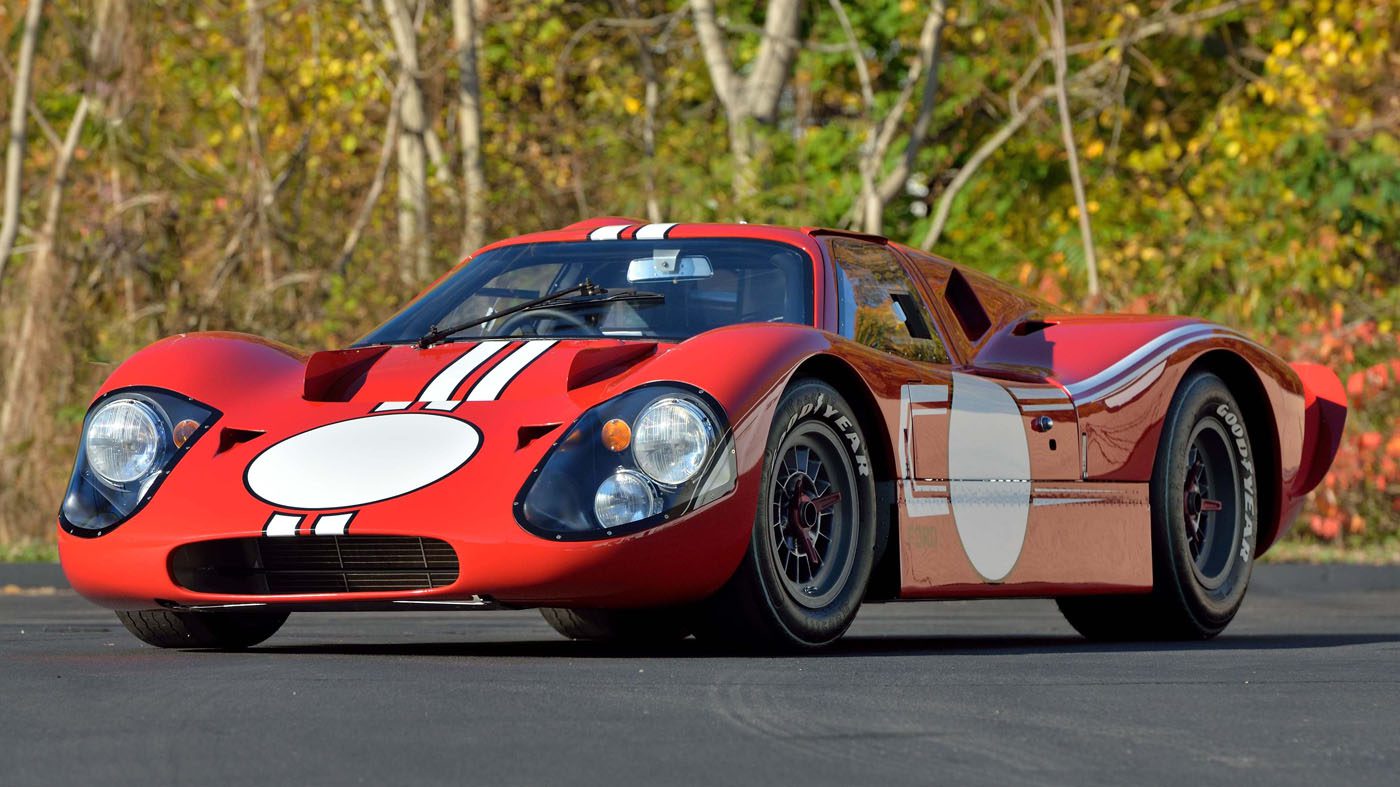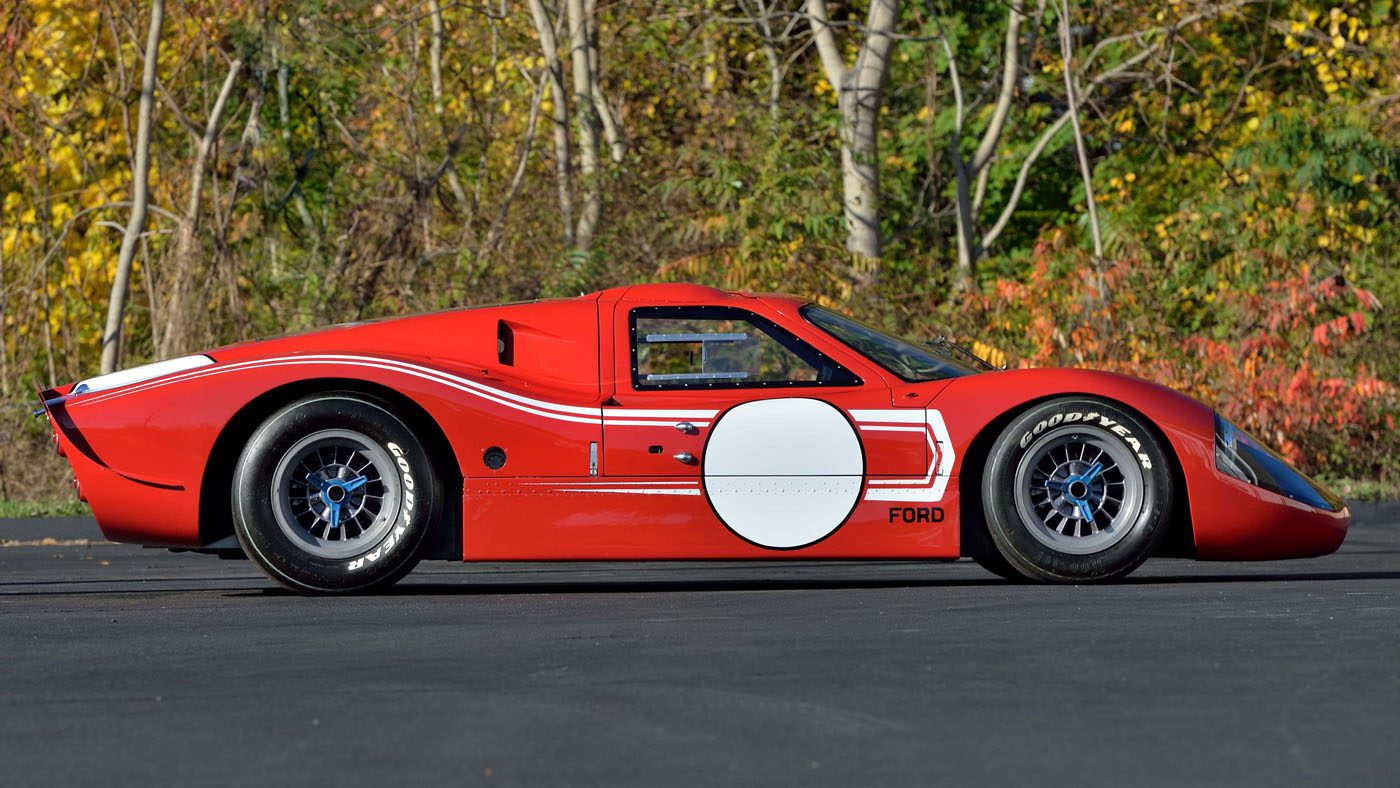
Presented by Mecum Auctions.
1967 Ford GT40 MK IV Being Auctioned At Mecum Kissimmee 2023
Even as the three GT40 Mk II racers were completing their famed 1-2-3 sweep of the 1966 24 Hours of Le Mans, Ford Motor Company and its in-house specialty contractor Kar Kraft of Brighton, Michigan, were hard at work creating an all-American successor to the Anglo-American Mk II: the “J-Car.” Named in reference to the FIA’s Appendix J rules for sports prototypes, this all-new racer was based on a highly advanced chassis constructed of honeycomb-aluminum sandwich paneling produced by the Brunswick Aircraft Corporation. Lightweight and extremely rigid, the new chassis saved considerable weight compared to that of the more conventional Mk II, a crucial requirement in a car designed to carry the big iron-block, iron-head NASCAR 427 engine and the heavy-duty ancillaries it demanded.
Initial tests revealed serious aerodynamic problems, but extensive bodywork revisions by Shelby American Chief Engineer Phil Remington and subsequent relentless testing evolved the J-Car into the formidable GT40 Mk IV. The most technically advanced and powerful racing prototype ever built to its time, the Mk IV ultimately fulfilled Henry Ford II’s desire to build an all-American racer, driven by American drivers, to win the world’s greatest endurance race.
With Shelby-American drivers Dan Gurney and A.J. Foyt sharing duties, the Mk IV delivered a second consecutive victory for Ford at Le Mans in 1967 and also won the FIA’s Index of Thermal Efficiency as the most fuel-efficient entrant, an astounding achievement given its monstrous power. The GT40’s absolute dominance was thus established, and Ford’s resounding double defeat of Ferrari became one of the most memorable chapters in the history of motorsports. In just two races, Sebring and Le Mans, the Mk IV so overwhelmed the competition that the FIA rendered it illegal for 1968.
In the end, only 12 Mk IV chassis were built, the first four of which bore the original J-Car bodywork. Two of those were destroyed in testing, one instance of which took the life of the great Ken Miles. The second group of four were fitted with the Remington-developed Mk IV bodies and raced twice in 1967, compiling a perfect two-for-twi win record.
The last four chassis were left uncompleted when the FIA announced new rules for 1968 that disqualified the Mk IV from competition. Two of those chassis, J-9 and J-10, were built by Kar Kraft into open-cockpit racers using the remaining spares from the Le Mans effort. J-9 was fitted with a twin-element dihedral rear wing and was tested in Ford’s wind tunnel and at the company’s Michigan test track driven by Mario Andretti, but it was never raced. In February 1969, the entire lot—J-9, J-10 and all the remaining spares—were sold for $1 to Agapiou Racing in Los Angeles, owned by former Shelby mechanics Charlie and Kerry Agapiou. Ford attached one proviso: that they could buy everything back for the same price for the term of one year. That never came to pass.

The Agapiou brothers ambitiously took aim at the 1969 Can Am series with J-10, fitting it with new open-cockpit bodywork, a Chaparral-inspired high rear wing and Boss 429 power. In a two-year campaign that lasted through the 1970 season, J-10 was driven by such star drivers as Peter Revson, Jack Brabham, George Follmer, David Hobbs and Vic Elford, with Canadian John Cannon most often behind the wheel. Indeed, it was Cannon who drove J-10 to its best finish, placing second in that year’s Kyalami Group 7 invitational.
After a racing accident at the November 1970 LA Times Grand Prix at Riverside, the chassis was sent to Johnathan Thompson’s TC Prototypes in England for repair and restoration. J-10 then remained in the Agapiou brothers’ care until 1989, when Los Angeles real estate developer Martin Yacoobian purchased it and began rebuilding it to Mk IV configuration.
In 1996, approximately 70% complete, J-10 was purchased through Motor Classic Corporation in White Plains, New York, by ERA Replica Automobiles founders Jim Holden, Peter Portante and Jose Velez in New Britain, Connecticut. They continued the transformation to Mk IV specifications and completed a meticulous four-year restoration to exacting standards in 2017, including the creation of new bodywork using molds from chassis J-6 and fabricated by veteran Holman-Moody metalwork specialist Ken Thompson of North Carolina. The completed bodywork was finished in the 1967 Le Mans-winning J-5’s red and white No. 1 livery.
A thorough mechanical refurbishment was executed to the same demanding standards, including a correctly prepared 427 CI FE big-block V-8 mated to an exceedingly rare Ford-designed, Kar Kraft-built, all-synchromesh T-44 4-speed transaxle. The completed J-10 was presented to the public at the 2018 Amelia Island Concours d’Elegance to unanimous acclaim, the occasion recorded for posterity in an episode of Discovery Channel’s “Chasing Classic Cars” TV series.
As one of only 12 Mk IVs produced, Chassis J-10 is among the rarest racing prototypes of the 20th century, a valuable artifact of Ford’s historic undertaking to win the 24 Hours of Le Mans that was also driven in the classic Can Am series by some of the period’s greatest drivers. Documented with an unbroken ownership chain and painstakingly restored to authentic Mk IV presentation, J-10 is worthy of the highest concours honors, a prominent position in the vintage racing world and inclusion in the most prestigious collections.
This vehicle will be offered at MECUM Auctions annual Kissimmee Florida, The World’s Largest Collector Car Auction®, along with almost 4,000 cars and thousands of Road Art items. Taking place January 4-15, 2023. View more cars and register to bid online at https://drive.mecum.com/










